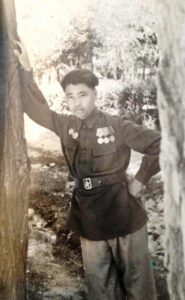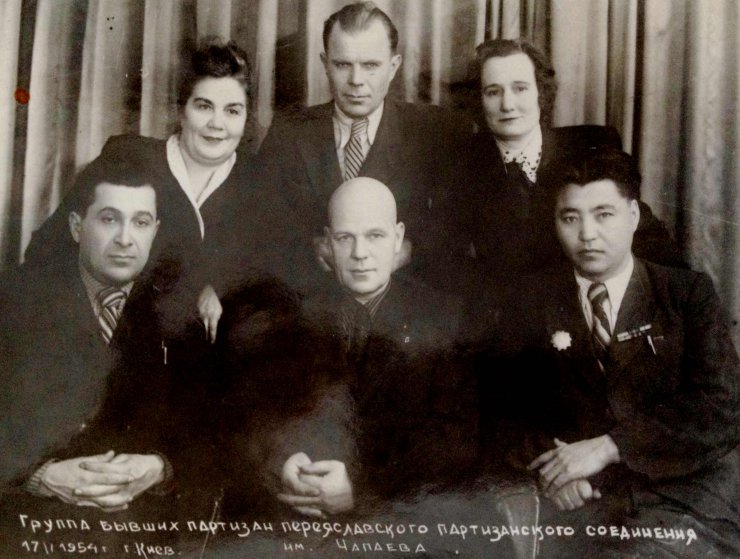ASTANA – Kasym Kaisenov, a frontline guerrilla fighter during World War II and a novelist whose chronicles explored the war’s legacy for a post-war generation, is being celebrated in Kazakhstan on his 105th anniversary on April 23.
Personal war experience and memories of his comrades

Kasym Kaisenov has served as a frontline guerrilla fighter in Ukraine. Photo credit: 365info.kz
From the standpoint of a guerrilla fighter, Kaisenov possessed a rare ability to link his personal experience and the memories of his comrades to describe a war that men were proud to be a part of.
Born in Asu Bulak village in the East Kazakhstan Region in 1918, Kaisenov was one of eight children in the family of his father Kaisa and mother Bizhamal of modest origins. His father was privileged to live till the age of 102.
In 1934, Kaisenov enrolled in a polytechnical college in Ust-Kamenogorsk after leaving school early.
As World War II broke out in 1939, he was drafted into the Soviet Army, then sent to a reconnaissance school near Moscow.
In the autumn of 1941, immediately after graduating from the reconnaissance school, Kaisenov was sent to the dense forest of then-occupied Ukraine on the frontlines of the Southwestern Front. Caught in a firefight he was the only one to survive among his fellow soldiers. Ten days later, hungry and dehydrated, he joined the guerrilla fighter group under Ivan Kuzmich Primak.
He commanded detachment number three named after the Civil War hero Chapayev as part of a large guerrilla unit of 7,000 men for two years. He was involved in guerrilla activities in Romania, then Czechoslovakia, and Moldova up until the end of 1944.
Kaisenov had a unique combination of qualities, being energetic, courageous, physically strong by nature, and lucky, as he admitted himself.

Kaisenov (fist row on the right) among former guerrilla fighters of the Pereyaslavl unit named after Chapayev. Kyiv, 1954. Photo credit: 365info.kz
Kaisenov was injured during the battles under Kiev and Poltava but kept fighting. He survived a battle with the Germans in 1943 while making a landing from an airplane in Moldova. He was also one of three people to survive the landing at the beginning of 1944 near Pleshoti in Romania.
When asked about those events much later, he said only his youth and luck that helped him to stay alive.
Among his numerous accomplishments as a guerrilla fighter is the capture of the Bukrin bridgehead, which led to the release of over 700 political prisoners from the Belaya Tanya concentration camp. The successful mission to free the prisoners from the heavily guarded camp is documented in books by notable figures such as Soviet Union Minister of Defense Marshal Andrei Grechko, General Vladimir Lavrinenkov, and military historian Dmitry Utkin.
Kaisenov was nominated for the title of Hero of the Soviet Union three times for his achievements, but by the will of fate never received the award. This did not bother Kaisenov. “I fought for my Motherland, and for that, I do not need any reward beyond the respect and love of my people,” he once said.
Writing during peacetime
He became a writer after returning to Almaty and joining the creative community in the 1950s. Writer Zhumagali Sain, who would become his lifelong friend, proposed that Kaisenov write memoirs about the war for a newspaper.

Kaisenov met with school-children to read his books. Photo credit: 365info.kz
His first book, “Young partisans,” published in 1954, chronicled the war through his own eyes. The book, which struck a chord with the public, helped Kaisenov to discover his occupation. He went on to publish two more books about World War II – “Ilko Vitryak” and “The partisans of Pereiaslav: Memoirs of a Partisan Detachment Commander.” His wartime experience was also reflected in a volume of essays.
By 1957, Kaisenov, beloved by many readers, became a member of the Writers’ Union of Kazakhstan. His approach to writing about war, describing the experience of millions of young men and women caught up in this terrible conflict, found its way to the hearts of readers.
His stories drew from original sources to paint a vivid picture of the physical and mental aspects of warfare, including the brutal realities of the battlefield, fear and courage, comradeship, and the ugliness of war.
Readers sent him photographs, letters, copies of combat operation orders, guerrilla fighters’ memoirs, and other material. Over the years, he accumulated a vast and priceless archive that needed to be put into a book. This memoir titled “From the claws of death” was published in 1960, and “A boy behind the enemy lines” and “On the Dnieper” were released a year later.
On the eve of the 50th anniversary of victory in the Great Patriotic War, Kaisenov was awarded the Khalyk Kaharmany (Hero of the Nation) title, the highest award in Kazakhstan for outstanding service to the country.
Kaisenov was also awarded the first and second-degree orders of the Great Patriotic War, the Order of Bogdan Khmelnitsky, and the partisans of Czechoslovakia award for his military achievements. The Ukrainian government awarded him with the second and third-degree Order For Special Courage.
He passed away in 2006 aged 89 after a prolonged illness.


